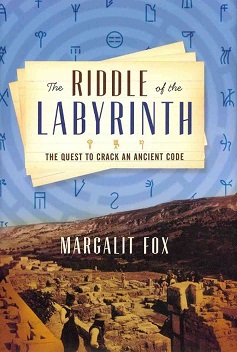
The Riddle of the Labyrinth
Margalit Fox
363 pages, including notes & index
published in 2013
Linear B is one of those ‘mysteries from history” I’d read about in the local library in the early eighties as a child, browsing through the stacks of occult, ancient astronaut and weird history books, listed along with better known examples like Schliemann’s quest for Troy. It’s one of those pieces of history I sort of, kind of knew about, of how tablets in an unknown language were found on Crete, providing evidence for the existence of a literate, “advanced” Bronze Age civilisation hundreds of years before the rise of the Classical Greek civilisations. But I never read much more about it because other subjects like Schliemann’s discovery of Troy looked much more interesting.
in The Riddle of the Labyrinth Margalit Fox sets out to prove me wrong by telling the real story of the decyphering of Linear B and Alice Kober, the largely forgotten woman at the heart of it, as well as of the archaeologist who found the tablets, Arthur J. Evans and the amateur linguist who finally decrypted them, Michael Ventris. In many ways this is a sad story: both Alice Kober and Michael Ventris died young, one dead of cancer, the other in a car accident, with Kober’s role in the decypherment for a long time remaining obscure because of her untimely death, while Ventris’ accident came at a time he was feeling depressed about what to do with the rest of his life… It’s also a detective story, as Fox tells the story of how the three of them each in turn helped the process of decyphering along.
Unlike the story of e.g. Rosalind Franklin — the uncredited woman behind the discovery of DNA, however — what this isn’t is yet another story about how a woman got swindled out of the credit for a major scientific discovery. It’s purely her illness and subsequent death that robbed her of her chance to decypher Linear B herself. Had those not interfered she might have done so years before Ventris had gotten the chance, the latter being careful to acknowledge his debt to her.
Fox starts her story with the discovery by Evans of the strange symbols on a Cretan sealstone given to him by a friend, symbols that he recognised as writing and his determined search to find more of it. Ultimately it led him, through the discovery of more such sealstones in Greek antiquaty shops to Knossos, which had been discovered in 1878 and where in 1900 Evans found his treasure trove of documents, fired clay tablets, part of the palace’s bookkeeping. More of the same would be found later at other Myceanean palaces.
The problem with Evans though was that he firmly believed Linear B was the alphabet for a hithero unknown Myceanean language, rather than Greek. He spent much of the rest of his life attempting to write the definitive treatment of the Minoean languages found on Crete, hoarding access to the existing Linear B tables to safeguard his project. It was this attitude as much as anything that delayed decyphering the language.
It’s at this point that Alice Kober enters the story, getting gripped by the Linear B bug in the 1930ties. Somewhat of a language geek, she spent her free time studying the language systematically as much as she could, ignoring the wild theorising that had sprung up about it in favour of an analytic approach. Her work was both helped and hindered when she gained the acquaintance of one of Evans disciplines and agreed to help him proofread Evan’s masterwork in return for access to his stack of Linear B tablets. What she discovered was that Linear B represented an inflected language being written in a syllabic script, something that had helped mislead earlier investigators.
Sadly though she died of cancer before she could’ve done more than lay the foundations for a sustained assault on the language and it was left to the architect and amateur linguist Michael Ventris to complete her work. Ventris had gotten intrigued by the language when he’d met Evans as a child and was told it was still undecyphered. that’s when Linear B got in his blood and what kept him working on it throughout his life, not helped by his somewhat diffident personality. At times he completely withdraw from the research, sinking into depression. In fact, Fox speculates that perhaps, once the initial euphoria about finally cracking the language had left him, his inner melancholy overwhelmed him and the car accident he died in might not have been entirely accidental…
Remains the language itself, interesting, but apparantly only used to hold inventories and help the palace bureaucracy; no stories had been written in it, no national epics discovered in it. A bit of a anticlimax perhaps, but the story as told by Fox is intriguing nonetheless.
